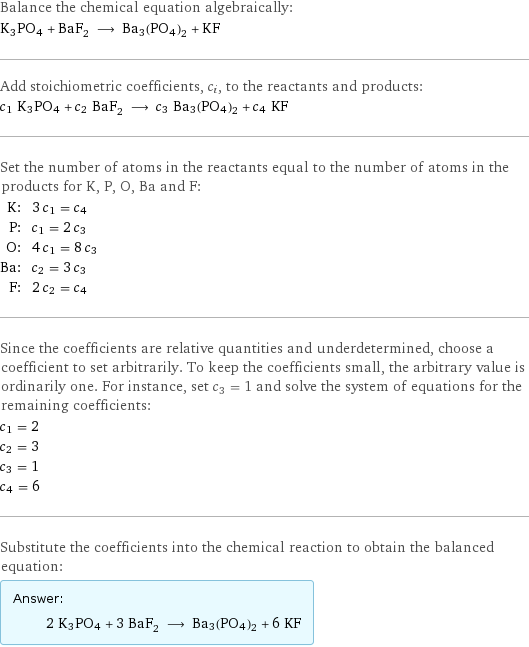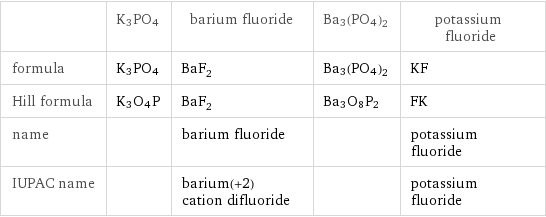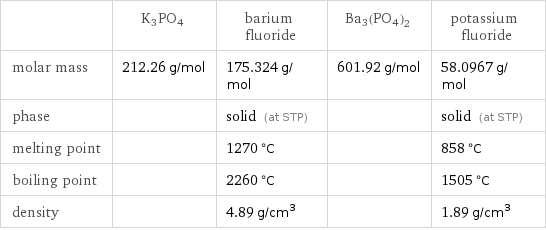Input interpretation

K3PO4 + BaF_2 barium fluoride ⟶ Ba3(PO4)2 + KF potassium fluoride
Balanced equation

Balance the chemical equation algebraically: K3PO4 + BaF_2 ⟶ Ba3(PO4)2 + KF Add stoichiometric coefficients, c_i, to the reactants and products: c_1 K3PO4 + c_2 BaF_2 ⟶ c_3 Ba3(PO4)2 + c_4 KF Set the number of atoms in the reactants equal to the number of atoms in the products for K, P, O, Ba and F: K: | 3 c_1 = c_4 P: | c_1 = 2 c_3 O: | 4 c_1 = 8 c_3 Ba: | c_2 = 3 c_3 F: | 2 c_2 = c_4 Since the coefficients are relative quantities and underdetermined, choose a coefficient to set arbitrarily. To keep the coefficients small, the arbitrary value is ordinarily one. For instance, set c_3 = 1 and solve the system of equations for the remaining coefficients: c_1 = 2 c_2 = 3 c_3 = 1 c_4 = 6 Substitute the coefficients into the chemical reaction to obtain the balanced equation: Answer: | | 2 K3PO4 + 3 BaF_2 ⟶ Ba3(PO4)2 + 6 KF
Structures

K3PO4 + ⟶ Ba3(PO4)2 +
Names

K3PO4 + barium fluoride ⟶ Ba3(PO4)2 + potassium fluoride
Equilibrium constant
![Construct the equilibrium constant, K, expression for: K3PO4 + BaF_2 ⟶ Ba3(PO4)2 + KF Plan: • Balance the chemical equation. • Determine the stoichiometric numbers. • Assemble the activity expression for each chemical species. • Use the activity expressions to build the equilibrium constant expression. Write the balanced chemical equation: 2 K3PO4 + 3 BaF_2 ⟶ Ba3(PO4)2 + 6 KF Assign stoichiometric numbers, ν_i, using the stoichiometric coefficients, c_i, from the balanced chemical equation in the following manner: ν_i = -c_i for reactants and ν_i = c_i for products: chemical species | c_i | ν_i K3PO4 | 2 | -2 BaF_2 | 3 | -3 Ba3(PO4)2 | 1 | 1 KF | 6 | 6 Assemble the activity expressions accounting for the state of matter and ν_i: chemical species | c_i | ν_i | activity expression K3PO4 | 2 | -2 | ([K3PO4])^(-2) BaF_2 | 3 | -3 | ([BaF2])^(-3) Ba3(PO4)2 | 1 | 1 | [Ba3(PO4)2] KF | 6 | 6 | ([KF])^6 The equilibrium constant symbol in the concentration basis is: K_c Mulitply the activity expressions to arrive at the K_c expression: Answer: | | K_c = ([K3PO4])^(-2) ([BaF2])^(-3) [Ba3(PO4)2] ([KF])^6 = ([Ba3(PO4)2] ([KF])^6)/(([K3PO4])^2 ([BaF2])^3)](../image_source/97677f580f74e380acab856274f2978c.png)
Construct the equilibrium constant, K, expression for: K3PO4 + BaF_2 ⟶ Ba3(PO4)2 + KF Plan: • Balance the chemical equation. • Determine the stoichiometric numbers. • Assemble the activity expression for each chemical species. • Use the activity expressions to build the equilibrium constant expression. Write the balanced chemical equation: 2 K3PO4 + 3 BaF_2 ⟶ Ba3(PO4)2 + 6 KF Assign stoichiometric numbers, ν_i, using the stoichiometric coefficients, c_i, from the balanced chemical equation in the following manner: ν_i = -c_i for reactants and ν_i = c_i for products: chemical species | c_i | ν_i K3PO4 | 2 | -2 BaF_2 | 3 | -3 Ba3(PO4)2 | 1 | 1 KF | 6 | 6 Assemble the activity expressions accounting for the state of matter and ν_i: chemical species | c_i | ν_i | activity expression K3PO4 | 2 | -2 | ([K3PO4])^(-2) BaF_2 | 3 | -3 | ([BaF2])^(-3) Ba3(PO4)2 | 1 | 1 | [Ba3(PO4)2] KF | 6 | 6 | ([KF])^6 The equilibrium constant symbol in the concentration basis is: K_c Mulitply the activity expressions to arrive at the K_c expression: Answer: | | K_c = ([K3PO4])^(-2) ([BaF2])^(-3) [Ba3(PO4)2] ([KF])^6 = ([Ba3(PO4)2] ([KF])^6)/(([K3PO4])^2 ([BaF2])^3)
Rate of reaction
![Construct the rate of reaction expression for: K3PO4 + BaF_2 ⟶ Ba3(PO4)2 + KF Plan: • Balance the chemical equation. • Determine the stoichiometric numbers. • Assemble the rate term for each chemical species. • Write the rate of reaction expression. Write the balanced chemical equation: 2 K3PO4 + 3 BaF_2 ⟶ Ba3(PO4)2 + 6 KF Assign stoichiometric numbers, ν_i, using the stoichiometric coefficients, c_i, from the balanced chemical equation in the following manner: ν_i = -c_i for reactants and ν_i = c_i for products: chemical species | c_i | ν_i K3PO4 | 2 | -2 BaF_2 | 3 | -3 Ba3(PO4)2 | 1 | 1 KF | 6 | 6 The rate term for each chemical species, B_i, is 1/ν_i(Δ[B_i])/(Δt) where [B_i] is the amount concentration and t is time: chemical species | c_i | ν_i | rate term K3PO4 | 2 | -2 | -1/2 (Δ[K3PO4])/(Δt) BaF_2 | 3 | -3 | -1/3 (Δ[BaF2])/(Δt) Ba3(PO4)2 | 1 | 1 | (Δ[Ba3(PO4)2])/(Δt) KF | 6 | 6 | 1/6 (Δ[KF])/(Δt) (for infinitesimal rate of change, replace Δ with d) Set the rate terms equal to each other to arrive at the rate expression: Answer: | | rate = -1/2 (Δ[K3PO4])/(Δt) = -1/3 (Δ[BaF2])/(Δt) = (Δ[Ba3(PO4)2])/(Δt) = 1/6 (Δ[KF])/(Δt) (assuming constant volume and no accumulation of intermediates or side products)](../image_source/f279923e11e9a2ea8668fefed49f2630.png)
Construct the rate of reaction expression for: K3PO4 + BaF_2 ⟶ Ba3(PO4)2 + KF Plan: • Balance the chemical equation. • Determine the stoichiometric numbers. • Assemble the rate term for each chemical species. • Write the rate of reaction expression. Write the balanced chemical equation: 2 K3PO4 + 3 BaF_2 ⟶ Ba3(PO4)2 + 6 KF Assign stoichiometric numbers, ν_i, using the stoichiometric coefficients, c_i, from the balanced chemical equation in the following manner: ν_i = -c_i for reactants and ν_i = c_i for products: chemical species | c_i | ν_i K3PO4 | 2 | -2 BaF_2 | 3 | -3 Ba3(PO4)2 | 1 | 1 KF | 6 | 6 The rate term for each chemical species, B_i, is 1/ν_i(Δ[B_i])/(Δt) where [B_i] is the amount concentration and t is time: chemical species | c_i | ν_i | rate term K3PO4 | 2 | -2 | -1/2 (Δ[K3PO4])/(Δt) BaF_2 | 3 | -3 | -1/3 (Δ[BaF2])/(Δt) Ba3(PO4)2 | 1 | 1 | (Δ[Ba3(PO4)2])/(Δt) KF | 6 | 6 | 1/6 (Δ[KF])/(Δt) (for infinitesimal rate of change, replace Δ with d) Set the rate terms equal to each other to arrive at the rate expression: Answer: | | rate = -1/2 (Δ[K3PO4])/(Δt) = -1/3 (Δ[BaF2])/(Δt) = (Δ[Ba3(PO4)2])/(Δt) = 1/6 (Δ[KF])/(Δt) (assuming constant volume and no accumulation of intermediates or side products)
Chemical names and formulas

| K3PO4 | barium fluoride | Ba3(PO4)2 | potassium fluoride formula | K3PO4 | BaF_2 | Ba3(PO4)2 | KF Hill formula | K3O4P | BaF_2 | Ba3O8P2 | FK name | | barium fluoride | | potassium fluoride IUPAC name | | barium(+2) cation difluoride | | potassium fluoride
Substance properties

| K3PO4 | barium fluoride | Ba3(PO4)2 | potassium fluoride molar mass | 212.26 g/mol | 175.324 g/mol | 601.92 g/mol | 58.0967 g/mol phase | | solid (at STP) | | solid (at STP) melting point | | 1270 °C | | 858 °C boiling point | | 2260 °C | | 1505 °C density | | 4.89 g/cm^3 | | 1.89 g/cm^3
Units
